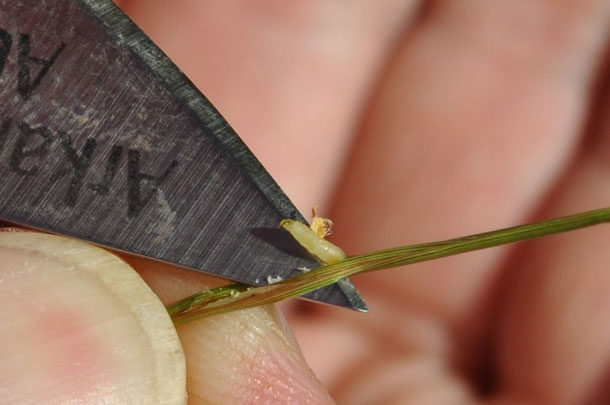Fall armyworm
“Fall armyworm is native to the tropical regions of the Western Hemisphere, from the U.S. to Argentina,” says Dr. John Capinera, University of Florida. “It normally overwinters successfully in the U.S. only in southern Florida and southern Texas. The fall armyworm is a strong flier, and disperses long distances annually during the summer months. It has been recorded in virtually all states east of the Rocky Mountains. However, as a regular and serious pest, its range tends to be mostly the southeastern states.
“The life cycle is completed in about 30 days during the summer, 60 days in the spring and autumn, and 80 to 90 days during the winter,” Capinera says. “The number of generations is reported to be one to two in Kansas, three in South Carolina and four in Louisiana. In coastal areas of north Florida, moths are abundant from April to December, but some are found even during the winter months.”
The adults lay masses of several hundred eggs, which hatch in two to three days. The larvae feed in groups when they are young and disperse as they mature. There are six instars in the fall armyworm life cycle. Young larvae are greenish with a black head, but the head acquires an orange tint in the second instar. In the second (but particularly the third) instar, the dorsal surface of the body becomes brownish and lateral white lines begin to form. In the fourth to sixth instars, the head is reddish brown, mottled with white, and the brownish body bears white lines. Elevated spots occur dorsally on the body; they are usually dark in color and bear spines. The face of the mature larva is also marked with a white inverted "Y."
Grasshoppers
“Grasshoppers cause some damage every year, but they become very destructive in large populations usually preceded by several years of hot, dry summers and warm autumns,” says Dr. Carl Patrick, Texas A&M AgriLife Extension Service. “Dry weather increases nymph and adult survival, and warm autumns allow grasshoppers more time to feed and lay eggs. Grasshoppers have a high reproductive capacity. The female lays an average of 200 eggs per season and sometimes as many as 400 eggs. If favorable weather increases the number of eggs and survival of nymphs and adults, the grasshopper population may be dramatically larger the following year.”
Patrick says there are many species of grasshoppers, but not all of them feed on crops. “The adults that damage crops become numerous during midsummer and deposit eggs during the last half of summer through fall. Usually one generation of grasshoppers is produced each year. Grasshoppers deposit their eggs one-half to 2 inches below the soil surface in pod-like structures. They deposit eggs in fallow fields, ditches, fencerows, shelterbelts, crop fields, hay fields and other weedy areas. Eggs begin hatching in late spring.”
Bermudagrass stem maggot
If your bermudagrass pasture or hayfield looks frosted in the middle of the summer, it is probably infested with bermudagrass stem maggot rather than affected by cold weather. The bermudagrass stem maggot (Atherigona reversura) is becoming more common across the southeastern U.S.
“In the U.S., bermudagrass stem maggot is only a problem on bermudagrass and stargrass (Cynodon spp.),” says Dr. William Hudson, University of Georgia. “Adult flies may go unnoticed because they are small and yellow with dark eyes. The fly lays its eggs on the bermudagrass near a node. Larvae are yellowish, grow to be about one-eighth of an inch long and may be hard to find because they often have left the stem by the time the plant shows symptoms of damage. Multiple generations hatch each summer. The fly has a life cycle that usually lasts about three weeks, with seven to 10 days spent in the soil as a pupa.
“Upon hatching from the egg, the maggot, or larva, works its way toward the last plant node – where the leaf blade emerges from the stem. As the maggot develops, it burrows in the shoot and feeds. The leaves – usually the top two or three above the feeding site – wither and die, resulting in potential yield loss. Death of these upper leaves, while the lower leaves remain green, causes the frosted appearance. The shoot stops elongating as a result of the insect’s feeding. In response to the damage, the plant may grow another shoot from a lower node of the affected portion. The tip of the new shoot can also be attacked by later generations of the bermudagrass stem maggot.”
If you raise forages in the Southeast, watch for these insects. Scout your fields and pastures at least once a week. If insect damage is observed, identify the insect, determine if the amount of damage warrants treatment and if so, select an insecticide registered for that use. Technical help can be obtained from the county agricultural extension agent. FG
Robert Fears is a freelance writer based in Texas.
PHOTO
Bermudagrass stem maggots cause a frosted appearance in bermudagrass but are hard to track down, as they usually leave the field before damage appears. Photo provided by University of Arkansas.









